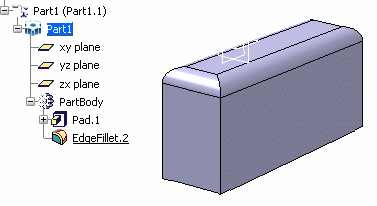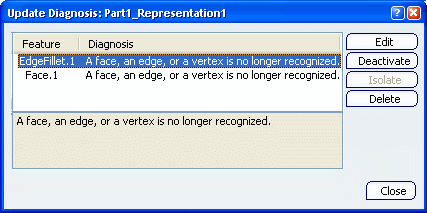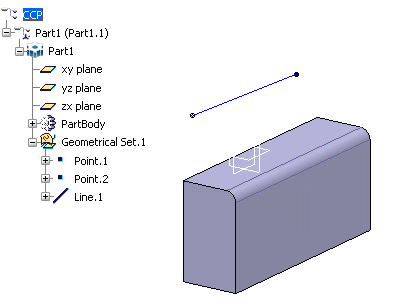Pasting Objects as Special | ||||
|
| |||
Paste Solid Objects As specified in Part document
You can select a solid object in the specification tree then paste it As specified in Part document.
The solid object is pasted with its design specifications, each component number being incremented.
| Important:
For a solid with surface
features, it is recommended to use multi-selection to select
individually each object to be copied. To make sure to copy
all the desired objects, select
or to display the
genealogical relationships between the different components. Another method is to use PowerCopies. For more information, see Generative Shape Design User's Guide: Managing Power Copies. |
![]()
Paste Solid Objects As Result With Link
You can select a solid object in the specification tree then paste it As Result With Link.
The solid object is pasted without its design specifications. It is identified by one of these two symbols:
| Symbol | Meaning |
|---|---|
 |
Geometry has been pasted to the same
document and is still linked to the original object. It can be manually updated whenever the original object is
modified. Geometry is located under a body named "Body.n", "n" being incremented according to the number of existing bodies.If the original body has been previously renamed through and if the In the main object check box is selected in , the copy is located under a body named "Result of BodyUserName" |
 |
Geometry has been copied from an object window different from the object window to which it has been pasted. |
![]()
Paste Solid Objects As Result
You can select a solid object in the specification tree then paste it As Result.
A solid is created under a body as explained below:
| Paste destination | If... |
|---|---|
| Body.n | |
| Original body name | The original body has been previously renamed via . |
| Result of BodyUserName | The original body has been renamed and
if the In the main
object check box is selected in
. The resulting solid can, in turn, be copied on the condition that it is pasted onto a mechanical body and in the first position in the mechanical body (in case there is no body to paste the solid, a new body is created). |
Important:
|
![]()
Paste Surface Objects Onto a Part Body
You can select a surface object in the specification tree then paste it onto a part body.
The surface object is pasted.
| Paste destination | If... |
|---|---|
| Current body | The body is suitable. The copy number is incremented accordingly. |
| First available geometrical set | There is a geometrical set.The copy number is incremented accordingly. |
| A new geometrical set | No geometrical set already exists. |
![]()
Paste Surface Objects Without Specifying the Paste Location
You can select a surface object in the specification tree then paste it without selecting any paste location.
The surface object is pasted.
| Paste destination | If... |
|---|---|
| Current geometrical set | The geometrical set is suitable. The copy number is incremented accordingly. |
| First available geometrical set | There is a geometrical set. The copy number is incremented accordingly. |
| A new geometrical set | No geometrical set already exists. |
![]()
Paste Surface Objects As specified in Part document to a New Object
You can select a surface object in the specification tree then paste it As specified in Part document to a new object.
The surface object is pasted.
| Paste destination | If... |
|---|---|
| Current body | The body is suitable. |
| First available geometrical set | There is a geometrical set. The copy number is incremented accordingly. |
| A new geometrical set | The current body is not suitable and no geometrical set already exists. |
![]()
Paste Surface Objects As Result With Link to a New Object
You can select a surface object in the specification tree then paste it As Result With Link to a new object.
The surface object is pasted.
| Paste destination | If... |
|---|---|
| Node named "External References" | You select a part body, the part itself or no paste destination at all. |
| Geometrical set | You select a geometrical set. |
Important:
Whatever the paste destination, the pasted element displays a green
symbol indicating that it has been copied from an object different from the
object it is pasted to and that it is synchronized with its
reference.
indicating that it has been copied from an object different from the
object it is pasted to and that it is synchronized with its
reference. |
![]()
Paste Surface Objects As Result to a New Object
You can select a surface object in the specification tree then paste it As Result to a new object.
The surface object is pasted.
| Paste destination | If... |
|---|---|
| Current body | The body is suitable. |
| First available geometrical set | There is a geometrical set. The copy number is incremented accordingly if an object with the same name already exists. |
| A new geometrical set | The current body is not suitable and no geometrical set already exists. |
Important:
Whatever the paste destination, the pasted element displays a red
symbol
 indicating that the pasted element is isolated, i.e. it can
no longer be edited. indicating that the pasted element is isolated, i.e. it can
no longer be edited. |




 in the specification tree.
in the specification tree.
